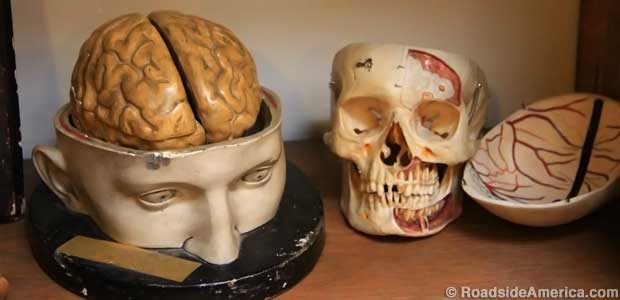
The brain goes here. Vintage training tools for doctors from the Indiana Hospital for the Insane.
Indiana Medical History Museum: Brains in Jars
Indianapolis, Indiana
Indiana had too many crazy people in 1895. Keeping them in an asylum was expensive. So the Indiana Hospital for the Insane built a medical center to find physical, treatable, causes for craziness. Its research material? The bodies of dead patients at the Indiana Hospital for the Insane.
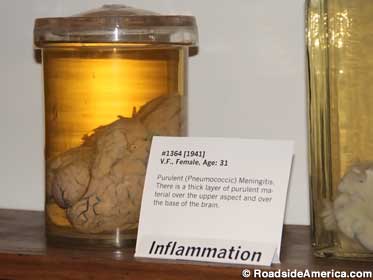
This particular brain has been pickled since 1941.
The Pathological Department Building, as it was called, stands isolated today on the grounds of the hospital, which closed in 1994. Recast as the bland-sounding Indiana Medical History Museum, it is in fact a unique, self-contained collection of equipment, supplies, furnishings, records, and body parts -- particularly brains. It will never be called the Brains of the Insane Museum, which is more descriptive -- but perhaps not reflective of advances in how mental illness is regarded these days.
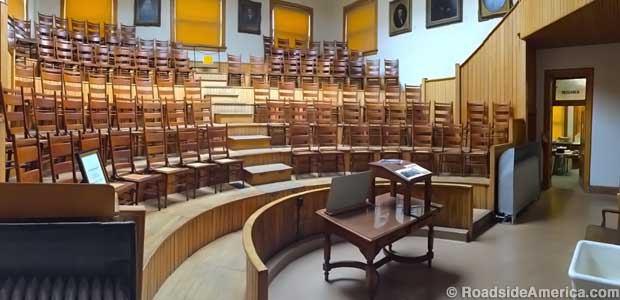
The corpse-draining table was wheeled into the amphitheater for public autopsies. Note slop sink on right.
"Not everybody who died at the hospital was autopsied, but everybody who was autopsied died at the hospital," said Sarah Halter, the museum's energetic Executive Director. "The doctors would get permission, kind of by default. A lot of the people were wards of the state; they didn't have families to object." And when there were families, they could be swayed by offering them a free funeral for the body if they said Yes.
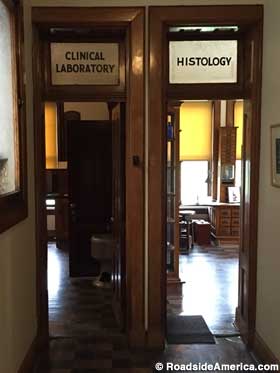
Body parts of the insane had many possible destinations.
Live patients were also used as research material. For years the hospital injected the blood of people infected with malaria into patients with syphilis, believing that the subsequent high fever would kill the disease. Sarah described this method as "pretty scary," but added that "for most patients, the worst that would happen is that they didn't get better."
A walk through the old building is like a tour of a historic home, but instead of seeing four-poster beds and fancy dinnerware you'll see corpse-draining tables and brains in jars. Everything is pretty much as it was in 1895, because once the building opened it lacked funding for major upgrades.
Cadavers were dissected either in the amphitheater (in front of audiences of students and doctors) or in the adjacent autopsy room. Noteworthy body parts would be preserved and displayed in the building's small anatomical museum. Everything else went to the building's chemistry or bacteriology labs, or to the histology room to be cut into slices and mounted on microscope slides. A photography studio used industrial-size cameras to turn the slides into classroom transparencies. A records room kept track of everything, in giant books filled with cursive handwriting.
Preserving the anatomical specimens was part art, part science. "Over time the formalin [preservative] gets cloudy and you get little 'floaties' that are kind of gross," said Sarah. When the brains need to be re-potted, Sarah brings in experts from the nearby Indiana University med school pathology department, and she's grateful for their help.
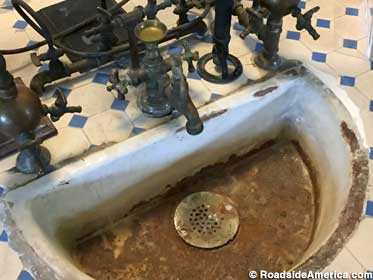
Visitors don't have to be told not to drink from this sink.
How many patients were sliced and diced at the Indiana Hospital for the Insane? No one will ever know, but Sarah said that roughly 1,450 autopsies were performed in the building until 1948, and they continued for another 20 years after that. We saw brains from patients whose disabilities ranged from idiocy and epilepsy to bullet wounds in the head. Did it help? "That's open for debate," said Sarah. "They didn't really have a lot of breakthroughs."
Because everything in the building is left out in the open, and because it's so old, the Museum can only be visited as part of a guided tour. That's for the visitors' protection as well as the museum's. "We don't want somebody to fall and face plant on some brain tissue," said Sarah.
Even the building's hand-crafted woodwork, exposed to the death goop of countless bodies, carries some risk. "You can't really sanitize wood," Sarah explained. "There are too many porous surfaces and cracks." So if you're touring the museum and you're cautioned to keep your sweaty hands off the counter tops -- you'd better listen.





